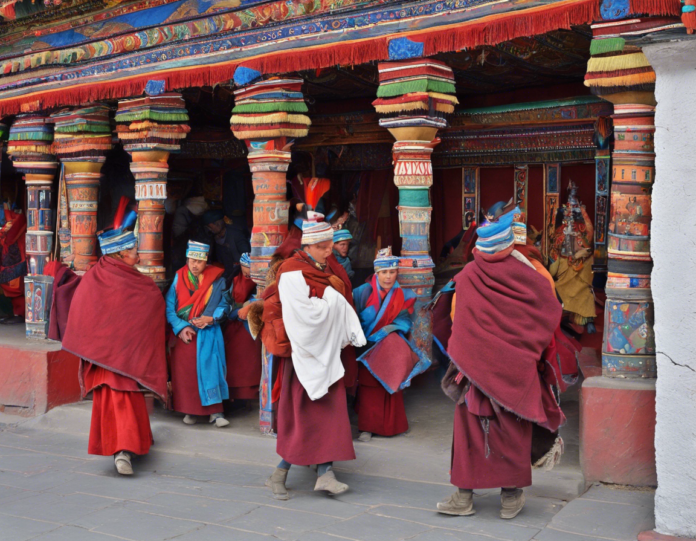Introduction
Nestled in the picturesque landscapes of Ladakh, India, Hemis Monastery is a renowned Buddhist monastery and a significant cultural hub in the region. With a rich history, vibrant traditions, and stunning architecture, Hemis Monastery attracts numerous visitors, pilgrims, and cultural enthusiasts from across the globe.
History of Hemis Monastery
The foundation of Hemis Monastery dates back to the 17th century, established by the Drukpa lineage. The monastery was founded by Stagsang Raschen, who was invited to Ladakh by the then ruler, Sengge Namgyal. Since its inception, Hemis Monastery has been an essential center for the teachings of the Mahayana Buddhism in the region.
Architecture and Design
One of the most striking features of Hemis Monastery is its architecture, which reflects a blend of Tibetan and Indian styles. The monastery complex comprises various structures, including shrines, stupas, prayer halls, and living quarters for the monks. The vivid and intricate frescoes, thangkas, and murals adorning the walls of Hemis Monastery showcase the rich artistic heritage of the region.
Treasures and Artifacts
Hemis Monastery is also famous for housing a valuable collection of thangkas, ancient scriptures, statues, and relics. The monastery is home to a copper-gilt statue of Lord Buddha, revered as one of the largest and most impressive statues in the region. The annual Hemis Festival is a significant event where this statue is unveiled to the public.
Spiritual Practices and Festivals
The monks of Hemis Monastery follow a rigorous schedule of meditation, chanting, and rituals as part of their spiritual practice. The monastery is particularly renowned for its vibrant festivals, with the Hemis Festival being the most popular. During this festival, masked dances, known as Cham dances, are performed by the monks, depicting various spiritual themes and stories.
Visiting Hemis Monastery
Tourists and pilgrims visiting Hemis Monastery can immerse themselves in the serene atmosphere of the monastery, participate in daily prayers, and explore the various treasures and artifacts housed within its walls. The picturesque surroundings of Hemis Monastery also offer opportunities for trekking and nature walks, allowing visitors to experience the beauty of Ladakh’s landscape.
Preservation and Conservation Efforts
In recent years, there has been a growing focus on preserving and conserving the cultural heritage of Hemis Monastery. Various initiatives have been undertaken to restore and maintain the ancient structures, artifacts, and artwork within the monastery, ensuring that future generations can continue to appreciate its beauty and significance.
Conclusion
Hemis Monastery stands as a testament to the rich cultural heritage and spiritual legacy of Ladakh. With its awe-inspiring architecture, ancient treasures, and vibrant traditions, Hemis Monastery continues to captivate the hearts and minds of all who visit. Whether you seek spiritual enlightenment, historical insight, or simply a peaceful retreat in the Himalayas, Hemis Monastery offers a truly immersive and unforgettable experience.
FAQs:
1. What is the best time to visit Hemis Monastery?
The best time to visit Hemis Monastery is during the summer months from May to September when the weather is pleasant and the roads are accessible.
2. Are there accommodation options near Hemis Monastery?
There are limited accommodation options near Hemis Monastery, including guesthouses and homestays in the nearby villages. It is advisable to make reservations in advance.
3. Is photography allowed inside Hemis Monastery?
Photography is generally allowed inside the monastery, but it is respectful to ask for permission before taking pictures, especially during religious ceremonies.
4. How can one reach Hemis Monastery?
Hemis Monastery is located approximately 45 kilometers southeast of Leh, the capital of Ladakh. Visitors can reach the monastery by road via private vehicles, taxis, or local buses.
5. What is the significance of the Hemis Festival?
The Hemis Festival is an annual event celebrated at Hemis Monastery to honor Guru Padmasambhava, the founder of Tibetan Buddhism. It is a vibrant and colorful festival featuring masked dances, music, and rituals.
6. Are there any trekking routes near Hemis Monastery?
Hemis Monastery serves as a starting point for various trekking routes, including the popular Hemis to Padum trek, offering trekkers a chance to explore the rugged beauty of the Himalayan region.
7. Can visitors participate in the daily rituals and prayers at Hemis Monastery?
Visitors are welcome to observe and participate in the daily rituals and prayers at Hemis Monastery, but it is essential to maintain decorum and respect the sanctity of the place.
8. Is there an entry fee to visit Hemis Monastery?
While there is no entry fee to visit Hemis Monastery, donations are appreciated to support the maintenance and upkeep of the monastery complex.
9. What are the nearby attractions to explore along with Hemis Monastery?
Visitors to Hemis Monastery can explore other nearby attractions such as Thiksey Monastery, Shey Palace, Stok Palace, and the Indus River for a comprehensive cultural and historical experience.
10. Are there any local shops or markets near Hemis Monastery to purchase souvenirs?
Visitors can find local shops and markets near Hemis Monastery where they can purchase traditional Ladakhi handicrafts, souvenirs, and Buddhist artifacts to take back home as mementos of their visit.

